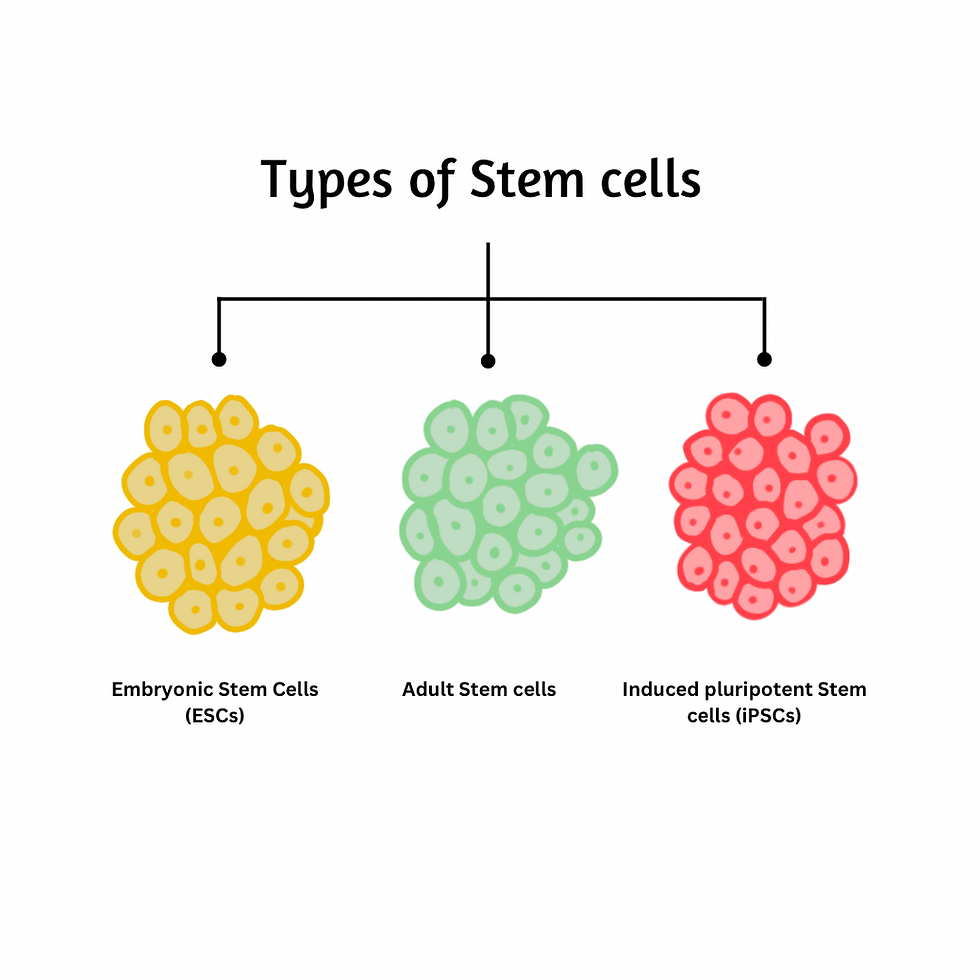Adult Stem Cells
- Neeha JV
- May 8
- 3 min read
Adult stem cells, also known as somatic or tissue-specific stem cells, are undifferentiated cells found in various tissues throughout the human body. Unlike embryonic stem cells, which are pluripotent and can become any cell type, adult stem cells are typically multipotent, meaning they can only develop into a limited range of cell types related to the tissue they originate from. Despite this limitation, adult stem cells play a vital role in maintaining and repairing the body’s tissues.
Origin and Location of Adult Stem Cells
Adult stem cells reside in specialized niches within different organs and tissues, remaining in a quiescent state until they are activated by injury or normal cell turnover. They have been identified in various locations, including:
Bone marrow: Produces blood cells (hematopoietic stem cells)
Brain: Generates neurons and glial cells (neural stem cells)
Skin: Regenerates skin cells
Muscles: Repairs muscle fibers
Intestines: Replenishes the lining of the gut
These stem cells ensure the ongoing renewal and maintenance of their respective tissues, preserving functionality throughout life.
Characteristics of Adult Stem Cells
Multipotency
The primary defining trait of adult stem cells is their multipotency. While they cannot form every cell type in the body like embryonic stem cells, they can generate various specialized cells within their tissue lineage. For example, hematopoietic stem cells in the bone marrow produce different types of blood cells, including red blood cells, white blood cells, and platelets.
Self-Renewal
Adult stem cells have the ability to self-renew, dividing and creating identical copies of themselves over extended periods. This ensures a stable supply of stem cells available for tissue maintenance and repair.
Role in Regenerative Medicine
Adult stem cells have become a cornerstone of regenerative medicine due to their ability to repair and replace damaged or diseased cells. Treatments based on adult stem cells include:
Bone marrow transplants: Used to treat leukemia and other blood-related conditions
Skin grafts: Aid in healing severe burns and wounds
Stem cell therapy for neurological diseases: Investigated for conditions like Parkinson’s and multiple sclerosis
Ongoing research aims to expand the therapeutic potential of adult stem cells, exploring their ability to treat a wider array of degenerative diseases and injuries.
Types of Adult stem Cells
Just to name a few:
Hematopoietic Stem Cells (HSCs):
Found in: Bone marrow, peripheral blood, and umbilical cord blood
Function: Form all types of blood cells (red cells, white cells, platelets)
Importance: Used in bone marrow transplants for treating leukemia and other blood disorders
Mesenchymal Stem Cells (MSCs):
Found in: Bone marrow, fat tissue, umbilical cord, and other tissues
Function: Differentiate into bone cells (osteoblasts), cartilage cells (chondrocytes), fat cells (adipocytes), and sometimes muscle or connective tissue cells
Importance: Used in regenerative medicine and tissue engineering
Neural Stem Cells (NSCs):
Found in: Brain regions like the subventricular zone and hippocampus
Function: Give rise to neurons, astrocytes, and oligodendrocytes
Importance: Potential for treating neurodegenerative diseases and brain injury
Epithelial Stem Cells:
Found in: Skin and linings of the gut and other organs
Function: Maintain and repair the constant turnover of epithelial tissues
Importance: Key in wound healing and skin regeneration therapies
Skeletal Muscle Stem Cells (Satellite Cells):
Found in: Muscle tissue
Function: Repair and regenerate damaged muscle fibers
Importance: Critical for muscle recovery and potential in treating muscular dystrophies
Endothelial Stem Cells:
Found in: Blood vessels
Function: Form and repair blood vessels (angiogenesis)
Importance: Studied for their role in wound healing and vascular diseases
Intestinal Stem Cells:
Found in: Crypts of the intestine
Function: Maintain and replenish the lining of the gut, which has a high turnover rate
Importance: Key for understanding gut

Advantages and Challenges
Advantages
Ethically non-controversial: Derived from adult tissues without harming embryos
Reduced risk of immune rejection: When harvested from the patient’s own body
Established medical applications: Successfully used in treatments like bone marrow transplants
Challenges
Limited differentiation potential: Restricted to specific cell lineages
Difficult to isolate and cultivate: Present in small quantities and require precise conditions for growth
Aging and mutations: Stem cells from older individuals may accumulate genetic damage
Conclusion
Adult stem cells are the body’s natural repair system, offering remarkable potential for medical therapies and tissue regeneration. While they have certain limitations compared to embryonic stem cells, their accessibility and proven clinical applications make them invaluable in the field of regenerative medicine. As research advances, adult stem cells will likely play an increasingly crucial role in developing innovative treatments for a wide range of diseases and injuries.




Comments